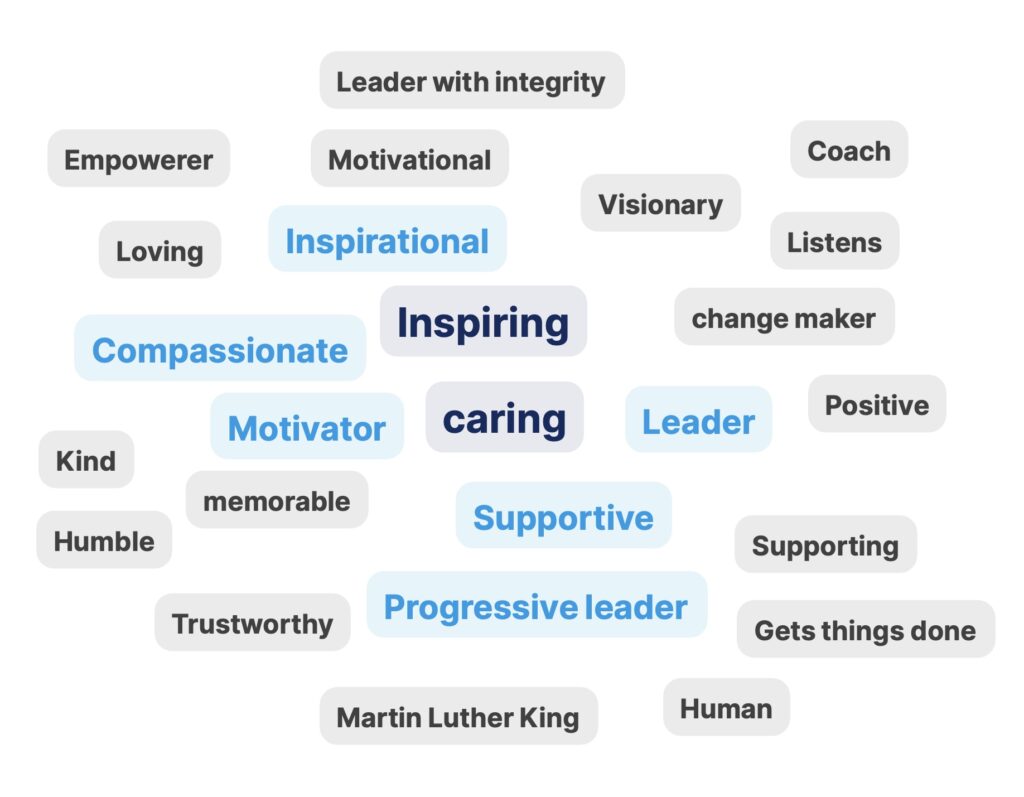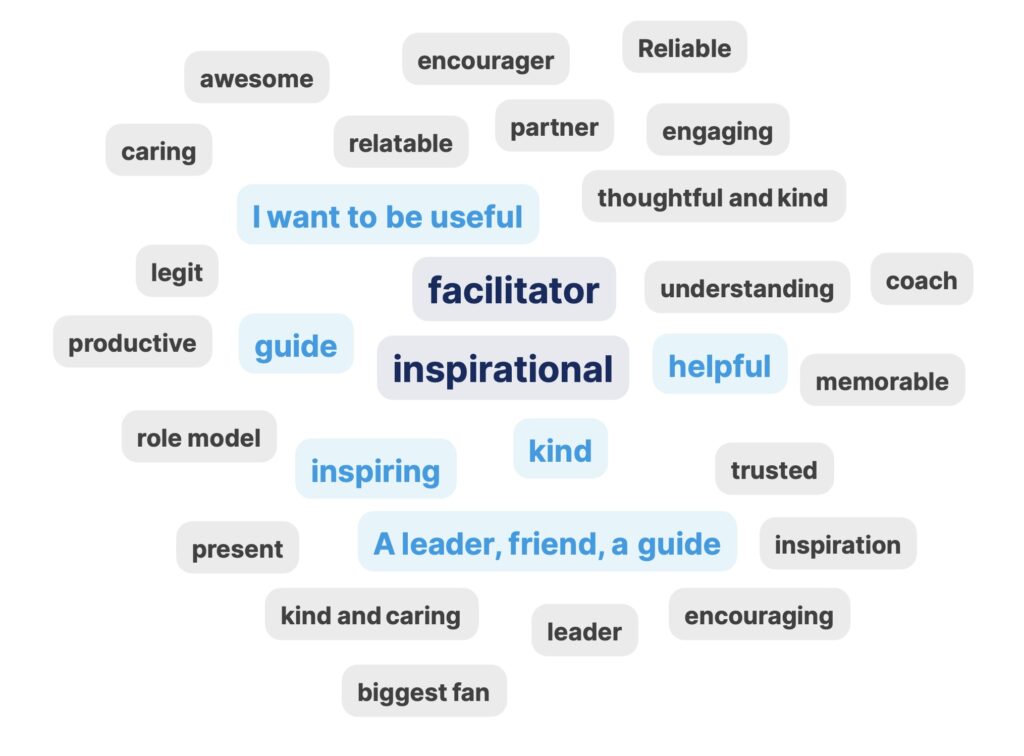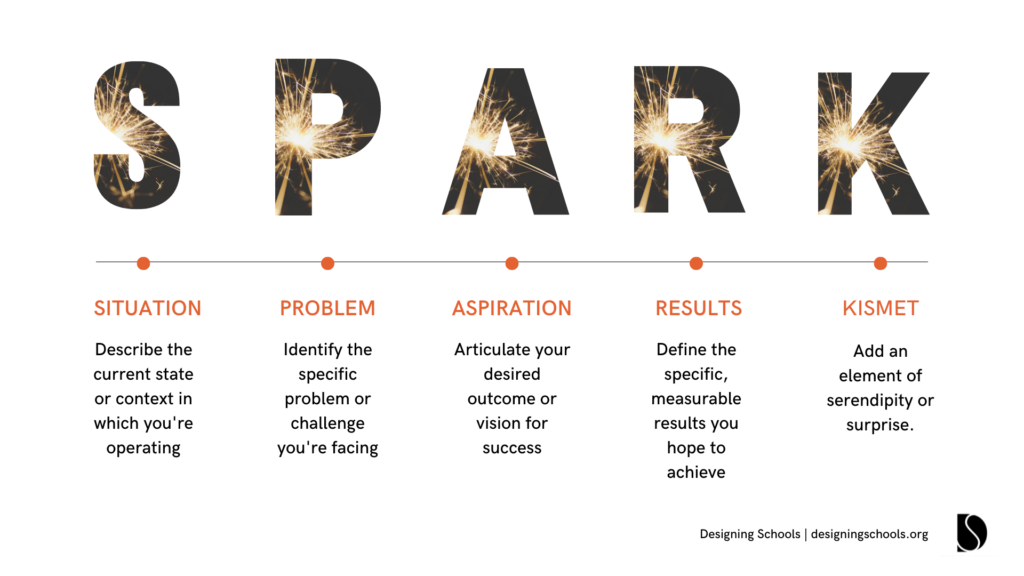Over the past six months, I’ve been listening and learning from schools and businesses as they share what they are curious about with AI and what makes them nervous. From keynote speeches to panel discussions, from radio shows to intimate conversations, I’ve experienced people being proactive, optimistic, and cautious about what’s next.
As many of you prepare to train people in your schools and organizations, I’m sharing the strategies that have worked well. And the 4 steps everyone needs to begin building their AI literacy skills and mindset.
AI Needs a Human SPARK: The 4 Steps Everyone Needs to Get Started
Question: Who Do You Want To Be
Whether it’s a keynote or a workshop this question is a non-negotiable for me.
“When thinking about your role, who do you want to be?”
Another way to think of this question I share is, “How do you want others to describe you.”
Not only do I want individuals to reflect on this question, but I want everyone in the room to hear the incredibly unique human qualities. This question is inspired by the book Atomic Habits by James Clear. Clear shares that our identity is an embodiment of our habits. And each action we perform is driven by the fundamental belief that it is possible. So, if we shift our identity, it’s easier to change our actions.
And in a world powered by AI where things are changing quickly, we have a lot of habits we need to change, and actions we need to take.
The unique qualities that people share that echo through the room as a reminder or what I call our Human Advantage in a world with AI. Yet each time one word tops the list each and every time:
INSPIRATIONAL.


At a time when we feel overwhelmed by technology, I want every person in the room to remember what makes humans unique. And the opportunity we have to be more of who we want to be.
Hi! Best Friend. Tell Me Can You…
This is by far the most successful analogy I’ve used to help people develop a mindset for how to interact with AI tools like ChatGPT. Meet your new best friend. You know the one you pour your heart out to, sharing every idea, every problem. The friend who listens to you talk and talk and maybe even offers you some advice. So I say, that problem you’ve got on your mind, that idea you want to try, that barrier that has been holding you back, share it with your new best friend.
We use the timeline below to ground ourselves in the idea that for the past 2 decades technology has been racing ahead and we have not kept pace. We layer the timeline with research that demonstrates we haven’t had a shortage of warnings of knowledge about what to do or why. Yet we have always struggled with how.

And this is what makes this technology different from others. It would be remiss to ignore the fact that this is not the first technology that has promised to save us time, boost our creativity, and enhance our efficiency. Yet the promise of technology has left many worse off than before.
Except for a rare few. Those who know how to use technology to SPARK new ideas, solve problems, and design the future. So why are some people able to SPARK great ideas for how to use technology, and others left in the dark? As author William Gibson shares, “The future is here. It just isn’t evenly distributed.”
Every AI Needs a Human SPARK
I firmly believe that every individual should be able to use technology to solve their problems, execute their ideas, and design their future. This belief was the inspiration behind my framework for interacting with AI – SPARK.

Whether it’s a keynote or workshop, or if it’s my amazing students inside “The AI Bootcamp,” the message is the same: Every AI needs a human SPARK.
But here’s what I tragically learned.
In our panopticon society, people have become akin to robots. Dreams have been forgotten, and people have become so accustomed to being cogs in this machine that they’ve lost sight of why they’re doing what they’re doing. It’s as if they’re sleepwalking through life, disconnected from their aspirations and potential.
When asked to break down their Situation, Problem, Aspiration, and Result, they struggle. It’s not that they lack the ability, but rather they’ve been conditioned to suppress it. They’ve forgotten how to tap into their unique human spark, their innate ability to dream, create, and solve problems.
In a world powered by AI, we must revive our human SPARK. Yes, it’s great that ChatGPT can write that email, but is really the biggest dream you have for the most advanced technology we’ve experienced in our lifetime?
After seeing the incredible feedback, I created a free guide that walks you through how to use ChatGPT and teaches others how to strengthen the human spark in an AI world. It’s not just about learning to use AI; it’s about rekindling that spark, reigniting your dreams, and reclaiming your role as a creator, not just a cog. (P.S. Scroll down to read how people feel after)

ChatGPT Made Simple in 4 Steps
These four steps help people spark ideas for how to use AI to solve problems, execute ideas, and imagine new ways of learning and working that were previously not possible. These strategies are encapsulated in a guide I’ve put together, and I want to share a brief overview of them with you:
STEP 1: Enter the AI World
Just like stepping foot in a new city, diving into the world of AI might seem a little intimidating with its unique interface and language. But the more you interact with it, the more familiar and exciting it becomes.
STEP 2: The Power of Prompts
Crafting the perfect prompt is key to guiding AI to get what you want. Think of it as having a conversation with a best friend where you’re sharing a problem, opportunity, or idea.
Step 3: Are We on the Same Page
Evaluate AI responses using specific criteria. Play detective, scrutinize the responses, and find areas for improvement in your prompts based on the feedback.
STEP 4: Continue the Conversation
Don’t shy away from asking tough questions. Push the boundaries of what you believe the AI can do. Experiment with different perspectives and ask for elaborations or analogies.
Prompts are the starting points for AI interactions, the seeds from which AI solutions grow.
As we continue to navigate the AI landscape, let’s remember that our role is not just to adapt, but to inspire. Let’s be the catalysts for change, the sparks that ignite the AI revolution.
Let’s be curious, let’s be creative, and let’s be inspirational. Let’s design the future, today!

I’m Sabba.
I believe that the future should be designed. Not left to chance.
Over the past decade, using design thinking practices I've helped schools and businesses create a culture of innovation where everyone is empowered to move from idea to impact, to address complex challenges and discover opportunities.
stay connected
designing schools